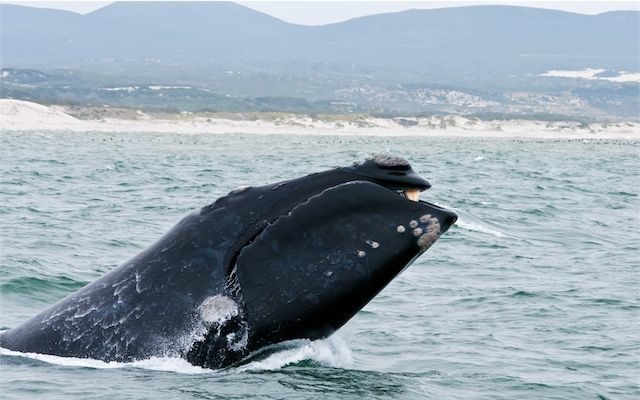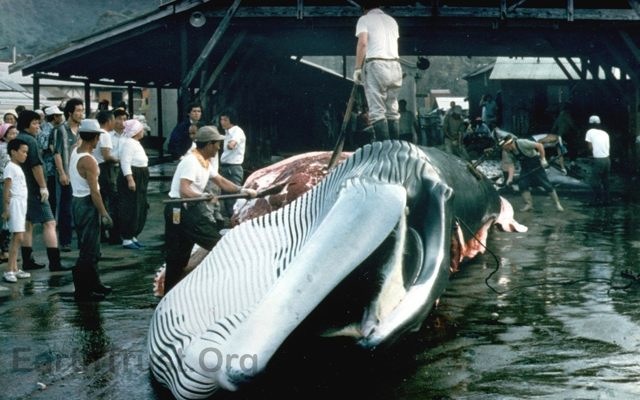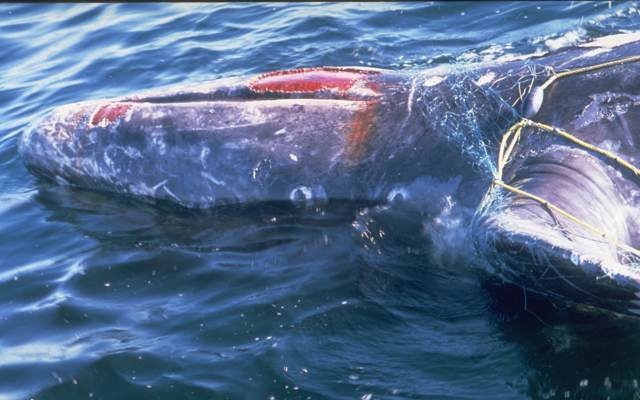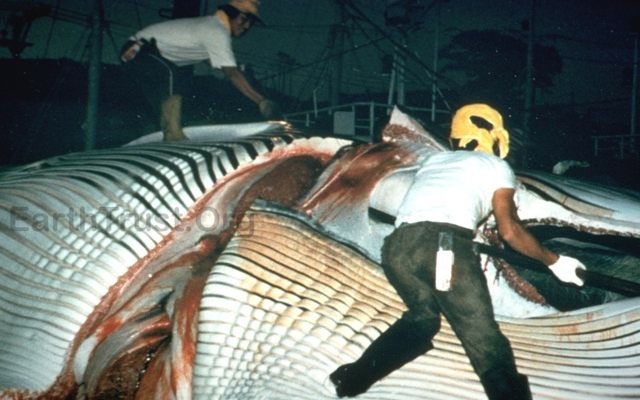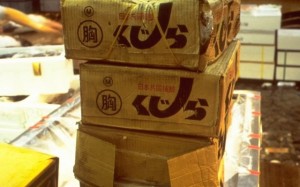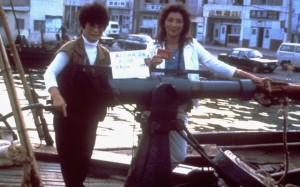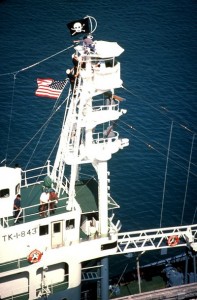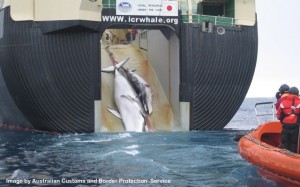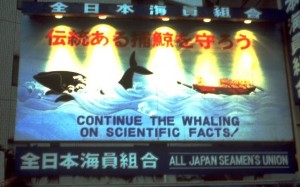A single pirate whaling ship can wipe out all whales in an area in a short time.
A Pirate Whaling story: Busting Korea.
When entire nations support illegal whaling on endangered species it can be a catastrophe. There’s no reporting to the whaling commission: a whale is quickly flensed into nondescript chunks of meat which may then be exported through organized-crime networks to the highest-paying market, which is usually Japan. There endangered species are a high-status luxury food among some consumers with too much money and too few scruples.
Once it is boxed, frozen and fraudulently labeled, it can be easily smuggled into Japan or other high-priced markets.
ET has investigated many incidents of whaling over the years, but one such mission that makes a good story is the Korean whaling at Ulsan. A former whaling port, ET’s Korean supporters reported rumors of ongoing illegal whaling via harpoon ship, but they also reported that the docs where the whales were flensed were off limits to anyone who might be a conservationist.
Proof was needed to present at the IWC to stop the whaling. The difficult part was getting into the whale-flensing area to get photo-documentation, and getting out alive. Angry pirate whalers with enormous flensing knives and an important secret to keep can make such an undertaking chancy.
So we sent Avon ladies.
The team of Olivia Young and Caroline Takahashi used Avon credentials to infiltrate the dock areas, because pirate whalers work hard in tough conditions and arguably could really use some cosmetics. And really, who suspects Avon ladies? They were able to get stunning pictures of fin whales being flensed, and even evidence of a right whale. But the fin whales weren’t being flensed in the daylight, so they had to use flash photography.
Now there are many things which might pass for inconspicuous on a dock where a huge whale is being illegally cut to pieces for the organized crime trade. Two avon ladies in dresses firing flash cameras weren’t among those things, so they were attacked by the blood-soaked whalers to confiscate their cameras.
It was about at that point that it became very useful that these Avon ladies were able to defend themselves. Olivia was a former Korean policewoman and Caroline no slouch herself. So it became an on-dock karate match between the Avon ladies and the whalers. (This was NOT a part of the ET plan; but in retrospect it IS part of the story).
The Avon ladies won, and for good measure Olivia chased the captain up the mast of his whaling ship, then got the crew arrested for hassling Avon ladies, by calling on her contacts in Korea’s police department.
So ended killer-ship whaling by the nation of Korea, which has not resumed since. The photos of whaling on endangered species were presented to the IWC as proof of a clear infraction of laws and treaties, and the nation of Korea began enforcing its existing laws and treaty obligations against illegal whale kills.
So was this a permanent victory for the whales? Well, that’s less clear. There has been no reported taking of whales by harpoon and killer ship since then. However, the Korean government allows whales “accidentally entangled” in nets to be cut up for sale. This seems reasonable. But with a single whale worth tens of thousands of dollars, it becomes very profitable for nets to be set to “accidentally entangle” whales.
Indeed, these accidents have become such a regular thing that the Ulsan whale-meat restaurants are well-supplied with hundreds of such “accidents” per year, at luxury-food prices. The “accidental take” is so reliable that there have been controversial plans to build a whalemeat processing factory.
We find there’s really no such thing as a permanent victory to save whales. It takes vigilance and work. And there are loud voices among whaling nations calling to disband the whaling commission and allow nations to take whatever they feel like taking.
So Korea’s whaling future may hinge on the value of their whale-watching industry versus the value of their whales-on-the-menu industry; and the willingness of other nations to embargo their products if they return to whaling on endangered and threatened species.
As for the ET campaign using Avon ladies, the Ulsan harpoon ships were shut down due to being exposed, and are not legal in Korea today by domestic law. That’s the sort of partial victory that we sometimes have to settle for, while working to protect endangered whale species worldwide.
Is Japan a pirate whaling nation?
Above, a protestor flies the Jolly Roger from the Japan “research whaling” ship Shonan Maru #2, as it heads to Peru to fire “recovery darts” into Brydes whales. Recovery darts can only provide data if the whale is flensed, and Brydes whales are not legal to take.
Japan has been the high-priced world market for whale meat – legal and illegal – for many decades.
It’s nearly impossible to discuss pirate whaling without talking about Japan. Historically, Japan has laundered the meat of hundreds of thousands of illegally-killed whales through its markets. It has set up “rogue client nations” to do regional whaling and flensing – complete with Japanese meat inspectors on site – and destroyed essentially all whales of all species in many areas. It conducted a huge high-seas collusion with the USSR which depopulated the southern hemisphere of humpbacks and other species.
The infamous pirate whaling factory-killer ships of South African Andrew Behr – The Sierra, Theresa, Susan, and Cape Fisher – all operated under contract to Japan’s firms. The meat was taken in the Atlantic by ships with a South African crew, flying a Somali Flag, the meat was graded by Japanese inspectors and marked “product of Spain” before being shipped to Japan via the Ivory Coast.
If there’s an illegal “whale meat cartel”, it is Japan’s intertwined network of government, corporations, and organized crime.
Dead mother and baby minke whales, being hauled aboard a Japanese factory ship doing “research”. Photographed by Australia’s Border Patrol agents. Japan’s still up to its old tricks, but it does get its web site up there for rebuttal. Almost like it knows its actions need heavily spun.
Seen in this context, it’s perhaps reasonable to consider ALL of Japan’s whaling and whalemeat activities Pirate Whaling. Nobody in the world really believes they are doing useful “whale research” when they send their ships south to blast whales. While basic data is taken, it’s clear the main purpose of the “research” is to bring home a bunch of whale meat, which in turn helps obscure and provide cover for the smuggled meat.
Humpbacks were protected by the IWC in 1966. When EarthTrust began doing DNA testing of Japan’s market in the ’90’s, there was fresh humpback meat on sale, even in the tiny subset of markets sampled. Do the math.
Billboard in Japan pushing the “science” of whaling. While chasing an endangered right whale? Perhaps that’s artistic license, but Japan’s main PR spin has been anti-science, notably in attacking EarthTrust’s DNA exposes of its illegal whalemeat marketing.

